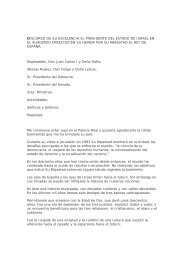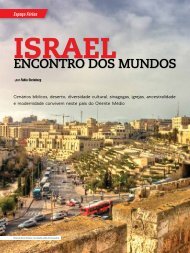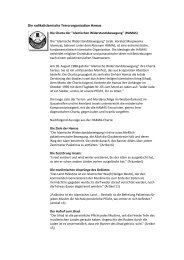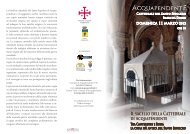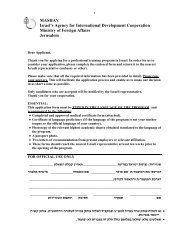Summary of the Verdict (TA 371/05) Estate of the Late Rachel Corrie ...
Summary of the Verdict (TA 371/05) Estate of the Late Rachel Corrie ...
Summary of the Verdict (TA 371/05) Estate of the Late Rachel Corrie ...
Create successful ePaper yourself
Turn your PDF publications into a flip-book with our unique Google optimized e-Paper software.
(TRANSLATION)<br />
<strong>Summary</strong> <strong>of</strong> <strong>the</strong> <strong>Verdict</strong> (T.A. <strong>371</strong>/<strong>05</strong>) <strong>Estate</strong> <strong>of</strong> <strong>the</strong> <strong>Late</strong> <strong>Rachel</strong> <strong>Corrie</strong>, etc.<br />
v. The State <strong>of</strong> Israel – Ministry <strong>of</strong> Defense<br />
1. The decedent, <strong>Rachel</strong> <strong>Corrie</strong>, was born on April 10, 1979. She was an American<br />
citizen, residing in Olympia, Washington. On March 16, 2003, <strong>the</strong> decedent was<br />
killed during an incident which is <strong>the</strong> focus <strong>of</strong> this lawsuit. She was 24 years old.<br />
The decedent was an activist in <strong>the</strong> International Solidarity Movement (hereafter:<br />
"<strong>the</strong> Organization" or "<strong>the</strong> ISM").<br />
2. In this lawsuit (T.A. <strong>371</strong>/<strong>05</strong>) <strong>the</strong> plaintiffs, <strong>the</strong> estate <strong>of</strong> <strong>the</strong> late <strong>Rachel</strong> <strong>Corrie</strong><br />
(hereafter: "<strong>the</strong> decedent"), <strong>the</strong> decedent's parents, bro<strong>the</strong>r and sister, are petitioning<br />
to direct <strong>the</strong> defendant, <strong>the</strong> State <strong>of</strong> Israel, to pay <strong>the</strong>m compensation for special<br />
damages and general damages inflicted on <strong>the</strong>m, <strong>the</strong>y claim, as a result <strong>of</strong> <strong>the</strong> death<br />
<strong>of</strong> <strong>the</strong> decedent during <strong>the</strong> incident that is <strong>the</strong> focus <strong>of</strong> this trial. In addition to <strong>the</strong><br />
aforementioned, <strong>the</strong> plaintiffs have petitioned to direct <strong>the</strong> defendant to pay<br />
"punitive damages".<br />
3. The plaintiffs claimed in <strong>the</strong>ir lawsuit that on March 16, 2003, <strong>the</strong> decedent,<br />
toge<strong>the</strong>r with o<strong>the</strong>r activists in <strong>the</strong> ISM, arrived at <strong>the</strong> "Philadelphi Corridor" in <strong>the</strong><br />
Rafiah area <strong>of</strong> <strong>the</strong> Gaza Strip where two bulldozers and an IDF tank were observed<br />
conducting operational activities in <strong>the</strong> area. The plaintiffs claimed that <strong>the</strong><br />
bulldozers were about to demolish a house in <strong>the</strong> area and that <strong>the</strong> decedent and<br />
her fellow members <strong>of</strong> <strong>the</strong> ISM stood in <strong>the</strong> path <strong>of</strong> <strong>the</strong> bulldozers in order to prevent<br />
<strong>the</strong>m from implementing <strong>the</strong>ir plan.<br />
In Article 8.5 <strong>of</strong> <strong>the</strong> Statement <strong>of</strong> Claim, <strong>the</strong> plaintiffs claimed as follows:<br />
"At 17:00 or <strong>the</strong>reabouts, <strong>the</strong> decedent<br />
stood near <strong>the</strong> house <strong>of</strong> Dr. Samir<br />
Nasrallah, which was designated for<br />
demolition, and one <strong>of</strong> <strong>the</strong> bulldozers<br />
was 10 to 15 meters from her. The<br />
bulldozers approached <strong>the</strong> decedent<br />
and pulled dirt from under her feet. The<br />
decedent fell and <strong>the</strong> blade <strong>of</strong> <strong>the</strong><br />
bulldozer ran over her leg and later <strong>the</strong><br />
bulldozer ran over her body. When <strong>the</strong><br />
bulldozer backed up <strong>the</strong> decedent was<br />
gravely injured and was bleeding<br />
extensively, although she was still<br />
breathing.<br />
The decedent was evacuated to <strong>the</strong> Al-<br />
Najer Hospital in Rafiah, where her<br />
death was declared after 20 minutes".
4. The plaintiffs claimed that <strong>the</strong> bulldozer intentionally caused <strong>the</strong> death <strong>of</strong> <strong>the</strong><br />
decedent. The plaintiffs based <strong>the</strong>ir claim on <strong>the</strong> following three grounds: assault,<br />
negligence and legal grounds.<br />
5. After hearing many witnesses from both sides, including expert witnesses, and<br />
studying <strong>the</strong> extensive summations from representatives <strong>of</strong> both sides, I hereby<br />
determine as follows:<br />
a. During <strong>the</strong> relevant period <strong>of</strong> time, <strong>the</strong> "Philadelphi Corridor" was <strong>the</strong><br />
site <strong>of</strong> daily warfare, i.e. daily gunfire by snipers, missile fire and IED<br />
explosions directed at <strong>the</strong> IDF forces. During this period, unceasing efforts<br />
were made to kidnap IDF soldiers. Only soldiers who were in combat units<br />
fought in <strong>the</strong> region.<br />
According to <strong>the</strong> notes made in <strong>the</strong> IDF records, from September 2000 to<br />
<strong>the</strong> date <strong>of</strong> <strong>the</strong> incident that is <strong>the</strong> focus <strong>of</strong> this lawsuit (March 16, 2003),<br />
nearly 6,000 grenades had been thrown at IDF forces in <strong>the</strong> Corridor;<br />
<strong>the</strong>re had been approximately 1,400 incidents <strong>of</strong> gunfire; and <strong>the</strong>re were<br />
more than 40 occurrences <strong>of</strong> mortar fire. These aforementioned events<br />
led to <strong>the</strong> injury and death <strong>of</strong> many Israelis.<br />
The United States government issued a travel warning on March 16,<br />
2003 to warn American citizens against visiting <strong>the</strong> Gaza Strip area<br />
or <strong>the</strong> West Bank.<br />
b. During <strong>the</strong> period pertinent to this case, <strong>the</strong>re was a military directive in<br />
force declaring <strong>the</strong> "Philadelphi Corridor" a "closed military area" and<br />
forbidding <strong>the</strong> entry <strong>of</strong> civilians.<br />
c. The ISM assigned itself <strong>the</strong> task <strong>of</strong> working alongside <strong>the</strong> Palestinians<br />
against <strong>the</strong> "Israeli occupation" by using what it called "non-violent<br />
protest activities". However, <strong>the</strong> evidence presented to me shows a<br />
significant gap between <strong>the</strong> Organization's statements and <strong>the</strong> true<br />
character <strong>of</strong> its activities and actions. The actions taken by <strong>the</strong><br />
members <strong>of</strong> <strong>the</strong> organization, in practice, do not match its<br />
statements. In fact, <strong>the</strong> Organization exploits <strong>the</strong> dialogue regarding<br />
human rights and morality to blur <strong>the</strong> severity <strong>of</strong> its actions, which<br />
are, in fact, expressed through violence.<br />
Inter alia, ISM activities included "defending" Palestinian families, even<br />
ones that were engaged in terror activities. The Organization's activists<br />
"specialized" in sabotaging <strong>the</strong> IDF's operational actions. ISM<br />
activities included, inter alia: stationing activists to serve as "human<br />
shields" for terrorists wanted by Israeli security forces; financial, logistical<br />
and moral assistance to Palestinians, including terrorists and <strong>the</strong>ir families;<br />
interrupting demolition activities or <strong>the</strong> sealing <strong>of</strong>f <strong>of</strong> houses<br />
belonging to terrorists who conducted suicide attacks with multiple<br />
casualties.
d. The mission <strong>of</strong> <strong>the</strong> IDF force on <strong>the</strong> day <strong>of</strong> <strong>the</strong> incident was solely to<br />
clear <strong>the</strong> ground. This clearing and leveling included leveling <strong>the</strong> ground<br />
and clearing it <strong>of</strong> brush in order to expose hiding places used by terrorists,<br />
who would sneak out from <strong>the</strong>se areas and place explosive devices with<br />
<strong>the</strong> intent <strong>of</strong> harming IDF soldiers. There was an urgency to carrying out<br />
this mission so that IDF look-outs could observe <strong>the</strong> area and locate<br />
terrorists <strong>the</strong>reby preventing explosive devices from being buried. The<br />
mission did not include, in any way, <strong>the</strong> demolition <strong>of</strong> homes. The<br />
action conducted by <strong>the</strong> IDF forces was done at real risk to <strong>the</strong> lives <strong>of</strong> <strong>the</strong><br />
soldiers. Less than one hour before <strong>the</strong> incident that is <strong>the</strong> focus <strong>of</strong><br />
this lawsuit, a live hand-grenade was thrown at <strong>the</strong> IDF forces.<br />
e. I hereby determine that, on <strong>the</strong> day <strong>of</strong> <strong>the</strong> incident, <strong>the</strong> two bulldozers and<br />
<strong>the</strong> armored personnel carrier were occupied with <strong>the</strong> clear military<br />
operational task <strong>of</strong> clearing <strong>the</strong> land in a dangerous area which<br />
posed a significant risk. The force's action was designed to prevent<br />
acts <strong>of</strong> terror and hostility, i.e. to eliminate <strong>the</strong> danger <strong>of</strong> terrorists<br />
hiding between <strong>the</strong> creases <strong>of</strong> land and in <strong>the</strong> brush, and to expose<br />
explosive devices hidden <strong>the</strong>rein, both <strong>of</strong> which were intended to kill<br />
IDF soldiers. During each act <strong>of</strong> exposure, <strong>the</strong> lives <strong>of</strong> <strong>the</strong> IDF fighters<br />
were at risk from Palestinians terrorists. As aforementioned, less than an<br />
hour before <strong>the</strong> incident that is <strong>the</strong> focus <strong>of</strong> this lawsuit, a live handgrenade<br />
was thrown at <strong>the</strong> IDF force.<br />
For this reason, I hereby determine that <strong>the</strong> act <strong>of</strong> clearing <strong>the</strong> land with<br />
which <strong>the</strong> IDF force was occupied during <strong>the</strong> event was "a war-related<br />
action" as defined in The Civil Wrongs Ordinance.<br />
f. On March 16, 2003, <strong>the</strong> decedent and her fellow ISM activists arrived at<br />
<strong>the</strong> location where <strong>the</strong> IDF force was working to clear <strong>the</strong> land. They did<br />
so, <strong>the</strong>y claim, in order to prevent <strong>the</strong> IDF force from demolishing<br />
Palestinian houses. They did so illegally and in contradiction <strong>of</strong> <strong>the</strong> military<br />
directive declaring <strong>the</strong> area a "closed military area". They held signs,<br />
stood in front <strong>of</strong> <strong>the</strong> bulldozers and did not allow <strong>the</strong>m to carry out <strong>the</strong>ir<br />
mission. The IDF soldiers informed <strong>the</strong> activists that <strong>the</strong>y had to distance<br />
<strong>the</strong>mselves from <strong>the</strong> area, threw stun grenades towards <strong>the</strong>m, fired<br />
warning shots towards <strong>the</strong>m and used methods to disperse<br />
demonstrations. All without avail.<br />
The IDF force was very careful not to harm <strong>the</strong> Organization's activists.<br />
Because <strong>of</strong> <strong>the</strong> activists' interference, <strong>the</strong> force repeatedly relocated to<br />
continue carrying out <strong>the</strong>ir mission.<br />
g. Based on <strong>the</strong> evidence presented to me, including <strong>the</strong> testimony <strong>of</strong> <strong>the</strong><br />
expert for <strong>the</strong> prosecution, Mr. Osben, I hereby determine that at<br />
approximately 17:00, <strong>the</strong> decedent stood roughly 15 to 20 meters from <strong>the</strong><br />
relevant bulldozer and knelt down. The bulldozer to which I refer was a<br />
large, clumsy and shielded vehicle <strong>of</strong> <strong>the</strong> DR9 model. The field <strong>of</strong> view <strong>the</strong>
ulldozer's operator had inside <strong>the</strong> bulldozer was limited. At a certain<br />
point, <strong>the</strong> bulldozer turned and moved toward <strong>the</strong> decedent. The bulldozer<br />
pushed a tall pile <strong>of</strong> dirt. With regard to <strong>the</strong> field <strong>of</strong> view that <strong>the</strong><br />
bulldozer's operator had, <strong>the</strong> decedent was in <strong>the</strong> "blind spot". The<br />
decedent was behind <strong>the</strong> bulldozer's blade and behind a pile <strong>of</strong> dirt and<br />
<strong>the</strong>refore <strong>the</strong> bulldozer's operator could not have seen her.<br />
The bulldozer moved very slowly, at a speed <strong>of</strong> one kilometer per hour.<br />
decedent saw <strong>the</strong> pile <strong>of</strong> dirt moving towards her, she did not move, as<br />
any reasonable person would have. She began to climb <strong>the</strong> pile <strong>of</strong> dirt.<br />
Therefore, both because <strong>the</strong> pile <strong>of</strong> dirt continued to move as a result <strong>of</strong><br />
<strong>the</strong> pushing <strong>of</strong> <strong>the</strong> bulldozer, and because <strong>the</strong> dirt was loose, <strong>the</strong><br />
decedent was trapped in <strong>the</strong> pile <strong>of</strong> dirt and fell.<br />
At this stage, <strong>the</strong> decedent's legs were buried in <strong>the</strong> pile <strong>of</strong> dirt, and when<br />
her colleagues saw from where <strong>the</strong>y stood that <strong>the</strong> decedent was trapped<br />
in <strong>the</strong> pile <strong>of</strong> dirt, <strong>the</strong>y ran towards <strong>the</strong> bulldozer and gestured towards its<br />
operator and yelled at him to stop. By <strong>the</strong> time <strong>the</strong> bulldozer's operator<br />
and his commander noticed <strong>the</strong> decedent's colleagues and stopped <strong>the</strong><br />
bulldozer, a significant portion <strong>of</strong> <strong>the</strong> decedent's body was already<br />
covered in dirt.<br />
The decedent's entire body was not covered in dirt. In fact, when <strong>the</strong><br />
bulldozer backed up, <strong>the</strong> decedent's body was seen to free herself from<br />
<strong>the</strong> pile <strong>of</strong> dirt and <strong>the</strong> decedent was still alive.<br />
The decedent was evacuated to <strong>the</strong> hospital and after 20 minutes, her<br />
death was declared.<br />
I hereby determine unequivocally that <strong>the</strong>re is no foundation to <strong>the</strong><br />
plaintiffs' claim that <strong>the</strong> bulldozer struck <strong>the</strong> decedent intentionally.<br />
This was a very unfortunate accident and was not intentional. No one<br />
wished to harm <strong>the</strong> decedent. I was convinced that <strong>the</strong> bulldozer's<br />
operator would not have continued to work if he had seen <strong>the</strong> decedent<br />
standing in front <strong>of</strong> <strong>the</strong> bulldozer, as he and his colleagues acted in similar<br />
circumstances earlier that day, when <strong>the</strong>y moved from location to location<br />
because <strong>of</strong> <strong>the</strong> disturbances caused by <strong>the</strong> members <strong>of</strong> <strong>the</strong> Organization.<br />
Because I find, as aforementioned, that <strong>the</strong> decedent was accidentally<br />
killed in <strong>the</strong> framework <strong>of</strong> a "war-related activity" as defined in The Civil<br />
Wrongs Ordinance, and in light <strong>of</strong> <strong>the</strong> instructions laid out in Article 5 <strong>of</strong><br />
<strong>the</strong> aforementioned ordinance, <strong>the</strong> State bears no responsibility for <strong>the</strong><br />
damages inflicted on <strong>the</strong> plaintiffs resulting from a war-related action.<br />
This makes superfluous <strong>the</strong> need to discuss <strong>the</strong> cause <strong>of</strong> action made by<br />
<strong>the</strong> plaintiffs because legally <strong>the</strong>ir demand should be rejected.<br />
Never<strong>the</strong>less, above and beyond what is necessary, I have also decided<br />
to discuss <strong>the</strong> cause <strong>of</strong> action filed by <strong>the</strong> plaintiffs as well as <strong>the</strong>ir o<strong>the</strong>r<br />
claims.
h. The plaintiffs claimed that evidentiary damage was done in two areas:<br />
first, <strong>the</strong>y claim that <strong>the</strong> Criminal Investigations Division (CID)<br />
investigation carried out after <strong>the</strong> event was sloppy and unpr<strong>of</strong>essional<br />
and led to evidentiary damage for <strong>the</strong> plaintiffs; <strong>the</strong> second area, which<br />
refers to <strong>the</strong> responsibility <strong>of</strong> <strong>the</strong> Institute for Forensic Medicine for<br />
evidentiary damage caused to <strong>the</strong> plaintiffs as a result <strong>of</strong> <strong>the</strong> violation <strong>of</strong><br />
<strong>the</strong> judicial order and <strong>the</strong> destruction <strong>of</strong> <strong>the</strong> recording documenting <strong>the</strong><br />
decedent's autopsy.<br />
It could be expected that, in light <strong>of</strong> <strong>the</strong> claim made above, <strong>the</strong> plaintiffs'<br />
representative would submit to <strong>the</strong> court <strong>the</strong> file <strong>of</strong> <strong>the</strong> investigation<br />
conducted by <strong>the</strong> CID so that I could form my own opinion regarding <strong>the</strong><br />
investigatory actions carried out and <strong>the</strong> manner in which <strong>the</strong> investigation<br />
was carried out, and to learn if <strong>the</strong> actions taken by <strong>the</strong> CID were<br />
sufficient or not. However, it was <strong>the</strong> plaintiffs that objected to submitting<br />
<strong>the</strong> full file <strong>of</strong> <strong>the</strong> investigation as evidence, even though <strong>the</strong> defendant<br />
agreed to do so. Thus did <strong>the</strong> plaintiffs, by <strong>the</strong>ir own actions, introduce<br />
circumstances in which an extremely important tool to examine <strong>the</strong>ir<br />
claims was denied to <strong>the</strong> court.<br />
After examining <strong>the</strong> evidentiary material and studying <strong>the</strong> claims made by<br />
representatives <strong>of</strong> both sides, I reached <strong>the</strong> conclusion that <strong>the</strong> CID<br />
investigation was conducted appropriately and without fault.<br />
i. With regard to <strong>the</strong> claims made regarding evidentiary damages relating to<br />
<strong>the</strong> Institute <strong>of</strong> Forensic Medicine:<br />
Investigators from <strong>the</strong> CID concluded that in order to advance <strong>the</strong><br />
investigation, an autopsy would have to be performed on <strong>the</strong> decedent. As<br />
a result, <strong>the</strong>y approached <strong>the</strong> District Court in Rishon LeZion and asked<br />
for a court order that would allow for such an autopsy. The court order<br />
"…that <strong>the</strong> body be autopsied at <strong>the</strong> Abu Kabir Institute for Forensic<br />
Medicine by a doctor who is not in <strong>the</strong> military and in <strong>the</strong> presence <strong>of</strong><br />
a representative <strong>of</strong> <strong>the</strong> American State Department" (Exhibit 6/T).<br />
Pr<strong>of</strong>essor Hiss testified that since <strong>the</strong> American Consulate saw no need to<br />
send a representative to be present at <strong>the</strong> autopsy, <strong>the</strong> autopsy was<br />
conducted, with <strong>the</strong> family's agreement, without a consular<br />
representative. He also testified that <strong>the</strong> Consulate sent a fax confirming<br />
that <strong>the</strong> autopsy could be conducted without a representative from <strong>the</strong><br />
family (Exhibit 11/T).<br />
After examining <strong>the</strong> evidentiary material and studying <strong>the</strong> claims made by<br />
representatives <strong>of</strong> both sides, I reached <strong>the</strong> conclusion that <strong>the</strong> plaintiffs'<br />
claim <strong>of</strong> evidentiary damage by <strong>the</strong> Institute for Forensic Medicine<br />
seems strange. This is because <strong>the</strong> decedent's fa<strong>the</strong>r himself testified that,<br />
from <strong>the</strong> outset, <strong>the</strong> family had no intention <strong>of</strong> conducting an autopsy and<br />
that <strong>the</strong>ir intention was to pursue <strong>the</strong> matter diplomatically in order to<br />
clarify what happened to <strong>the</strong> decedent. Moreover: it appears that <strong>the</strong>
decedent's family had no interest regarding <strong>the</strong> identity <strong>of</strong> <strong>the</strong> Consular<br />
representative that was to be present during <strong>the</strong> autopsy, nor in <strong>the</strong> type<br />
<strong>of</strong> pr<strong>of</strong>essional training <strong>the</strong>y had had. The family wanted a Consular<br />
representative to be present even if a secretary or typist had been sent!<br />
Pr<strong>of</strong>essor Hiss explained in his testimony that <strong>the</strong> aforementioned fax was<br />
sent to him after he telephoned <strong>the</strong> United States Embassy and asked<br />
that <strong>the</strong>y send an American doctor to be present at <strong>the</strong> autopsy. He<br />
claims that <strong>the</strong> embassy did not find a need to do so. Pr<strong>of</strong>essor Hiss<br />
asked to receive approval from <strong>the</strong> decedent's family and he <strong>the</strong>n<br />
received <strong>the</strong> fax 11/T in which it is specifically stated that <strong>the</strong> decedent's<br />
family agreed to <strong>the</strong> autopsy and that no o<strong>the</strong>r faxes would be sent.<br />
I believe that under <strong>the</strong>se circumstances, Pr<strong>of</strong>essor Hiss was well within<br />
his rights to conclude that, ultimately, <strong>the</strong> decedent's family conceded its<br />
demand for a representative to be present during <strong>the</strong> autopsy. The<br />
family's desire was to receive <strong>the</strong> decedent's body as soon as possible.<br />
Indeed, <strong>the</strong> family did not conduct any additional examinations after<br />
receiving <strong>the</strong> decedent's body and it was cremated: see Mr. Craig <strong>Corrie</strong>'s<br />
testimony.<br />
I am aware <strong>of</strong> <strong>the</strong> fact that, according to <strong>the</strong> language <strong>of</strong> <strong>the</strong> District<br />
Court's decision regarding <strong>the</strong> autopsy <strong>of</strong> <strong>the</strong> decedent's body, <strong>the</strong>re<br />
should have been a representative <strong>of</strong> <strong>the</strong> US Embassy present during <strong>the</strong><br />
autopsy. However, under <strong>the</strong> circumstances, when it was explained that<br />
<strong>the</strong> embassy saw no reason to send a representative, as Pr<strong>of</strong>essor Hiss<br />
testified, and because <strong>the</strong> fax sent to Pr<strong>of</strong>essor Hiss (11/T) stated that <strong>the</strong><br />
family agreed to <strong>the</strong> autopsy, we can understand why Pr<strong>of</strong>essor Hiss<br />
believed that <strong>the</strong>re was nothing preventing him from conducting <strong>the</strong><br />
autopsy without an embassy representative being present. There is no<br />
doubt that <strong>the</strong> proper course <strong>of</strong> action would have been to return to<br />
<strong>the</strong> District Court so that, in light <strong>of</strong> <strong>the</strong> change in circumstances, <strong>the</strong><br />
court could amend its decision and remove <strong>the</strong> condition regarding<br />
<strong>the</strong> presence <strong>of</strong> an embassy representative. However, given <strong>the</strong><br />
circumstances and in light <strong>of</strong> <strong>the</strong> aforementioned, it is not clear what<br />
evidentiary damage was made to <strong>the</strong> plaintiffs' case because <strong>of</strong> <strong>the</strong><br />
conduct <strong>of</strong> <strong>the</strong> Institute <strong>of</strong> Forensic Medicine.<br />
With regard to <strong>the</strong> plaintiffs' claim regarding <strong>the</strong> recording documenting<br />
<strong>the</strong> autopsy, I found no grounds to accept it. It is an audio recording (as<br />
opposed to a video recording) which served as a draft for Pr<strong>of</strong>essor<br />
Hiss when preparing his report. Recordings like this are made because,<br />
during an autopsy, <strong>the</strong> doctor's hands are holding scalpels and covered in<br />
blood, and <strong>the</strong>refore notes cannot be taken. Apparently, <strong>the</strong><br />
aforementioned audio recording simply does not exist anymore because,<br />
due to budgetary problems, <strong>the</strong> Institute <strong>of</strong> Forensic Medicine<br />
recycles tapes (see <strong>the</strong> testimony given by Pr<strong>of</strong>essor Hiss). Under<br />
<strong>the</strong>se circumstances, it is not clear what evidentiary damage was caused
to <strong>the</strong> plaintiffs as a result <strong>of</strong> <strong>the</strong> aforementioned draft having been erased<br />
due to recycling.<br />
In summation, with regard to evidentiary damages, I hereby<br />
determine that <strong>the</strong> two cumulative conditions necessary as laid out<br />
in <strong>the</strong> precedent determined by <strong>the</strong> Supreme Court were not upheld.<br />
They did not prove that evidentiary damage was caused which<br />
harmed <strong>the</strong>ir ability to prove <strong>the</strong>ir claims, nor did <strong>the</strong>y prove that <strong>the</strong><br />
defendant, through negligence, caused <strong>the</strong> claimed evidentiary<br />
damage.<br />
j. With regard to grounds for assault I hereby determine that <strong>the</strong>re is no<br />
foundation for such claims because <strong>the</strong>re is no component <strong>of</strong> "malice". As<br />
I have determined that <strong>the</strong> decedent was killed accidentally and not<br />
intentionally, legally <strong>the</strong> claim regarding grounds for assault must be<br />
rejected.<br />
k. With regard to grounds for negligence: I am convinced that, given <strong>the</strong><br />
circumstances created at <strong>the</strong> location <strong>of</strong> <strong>the</strong> incident, <strong>the</strong> actions taken by<br />
<strong>the</strong> force were without fault. Indeed, <strong>the</strong> field <strong>of</strong> vision <strong>of</strong> <strong>the</strong> bulldozer's<br />
operator was limited. However, <strong>the</strong> decedent's field <strong>of</strong> vision while she<br />
stood in front <strong>of</strong> <strong>the</strong> bulldozer and knelt down was open and without any<br />
limitation. The decedent could have distanced herself from any danger<br />
without any difficulty. However, she chose to take <strong>the</strong> risk described<br />
above, and that eventually led to her death.<br />
Given <strong>the</strong>se circumstances, I have reached <strong>the</strong> conclusion that it was not<br />
negligence on <strong>the</strong> part <strong>of</strong> <strong>the</strong> defendant or any <strong>of</strong> its representatives that<br />
caused <strong>the</strong> decedent's death. Therefore it can be understood that I reject<br />
<strong>the</strong> claim that <strong>the</strong>re is any foundation for <strong>the</strong> grounds <strong>of</strong> negligence in this<br />
case.<br />
The defendant claims a "willing endangerment" defense, in<br />
accordance with Article 5(A) <strong>of</strong> <strong>the</strong> Civil Wrongs ordinance. I reached<br />
<strong>the</strong> conclusion that <strong>the</strong> foundation for this defense, as determined by <strong>the</strong><br />
Supreme Court, has not been proven in this case, and <strong>the</strong>refore I hereby<br />
determine that <strong>the</strong> aforementioned defense does not exist with regard to<br />
this lawsuit.<br />
However, even though I have determined that it was not negligence on<br />
<strong>the</strong> part <strong>of</strong> <strong>the</strong> defendant or its representatives that led to <strong>the</strong> death <strong>of</strong> <strong>the</strong><br />
decedent, and although <strong>the</strong> aforementioned defense does not exist with<br />
regard to this lawsuit, it is not enough to change <strong>the</strong> result <strong>of</strong> rejecting this<br />
claim.<br />
l. With regard to legal grounds: It is true that <strong>the</strong> decedent was killed<br />
during <strong>the</strong> incident that is <strong>the</strong> focus <strong>of</strong> this lawsuit. However, in this case<br />
<strong>the</strong> defendant did not violate <strong>the</strong> decedent's right to life. The<br />
decedent put herself in a dangerous situation. She stood in front <strong>of</strong> a large
ulldozer in a location where <strong>the</strong> bulldozer's operator could not see her.<br />
Even when she saw <strong>the</strong> pile <strong>of</strong> dirt moving towards her and endangering<br />
her, she did not remove herself from <strong>the</strong> situation, as any reasonable<br />
person would have. The decedent began to climb <strong>the</strong> pile <strong>of</strong> dirt, got<br />
tangled up in it, fell and eventually died.<br />
The decedent's death was <strong>the</strong> result <strong>of</strong> an accident that <strong>the</strong> decedent<br />
caused. This occurred despite <strong>the</strong> efforts <strong>of</strong> <strong>the</strong> IDF force to distance her<br />
and her colleagues from <strong>the</strong> area.<br />
I believe that, under <strong>the</strong>se circumstances, <strong>the</strong>re is no justification to<br />
obligate <strong>the</strong> State to pay compensation for damages that <strong>the</strong> decedent<br />
could have prevented, but preferred not to, <strong>the</strong>reby choosing to risk her<br />
life as she did.<br />
Therefore, I reject <strong>the</strong> request to obligate <strong>the</strong> State to pay compensation<br />
on legal grounds.<br />
6. Because <strong>of</strong> this and in light <strong>of</strong> <strong>the</strong> aforementioned, I reject <strong>the</strong> lawsuit.<br />
Because <strong>of</strong> <strong>the</strong> circumstance surrounding <strong>the</strong> decedent's death, I will not make<br />
<strong>the</strong> plaintiffs' pay <strong>the</strong> legal expenses and each side will bear its own costs.




